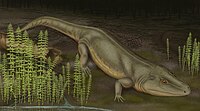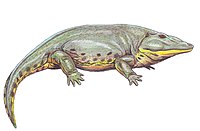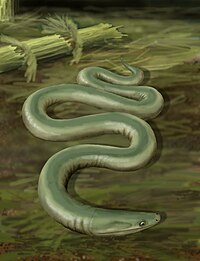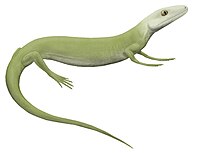Asselian
Template:Permian In the geologic timescale, the Asselian is the earliest geochronologic age or lowermost chronostratigraphic stage of the Permian. It is a subdivision of the Cisuralian epoch or series. The Asselian lasted between 298.9 and 293.52 million years ago (Ma). It was preceded by the Gzhelian (the latest or uppermost subdivision in the Carboniferous) and followed by the Sakmarian.[1]
Stratigraphy
The Asselian stage was introduced into scientific literature in 1954, when the Russian stratigrapher V.E. Ruzhenchev split it from the Artinskian. At that moment the Artinskian still encompassed most of the lower Permian - its current definitions are more restricted. The Asselian is named after the Assel River in the southern Ural Mountains of Kazakhstan and Bashkortostan.[2]
The base of the Asselian stage is at the same time the base of the Cisuralian series and the Permian system. It is defined as the place in the stratigraphic record where fossils of the conodont Streptognathodus isolatus first appear. The global reference profile for the base (the GSSP or golden spike) is located in the valley of the Aidaralash River, near Aqtöbe in the Ural Mountains of Kazakhstan.[3] The top of the Asselian stage (the base of the Sakmarian stage) is at the first appearance of conodont species Streptognathodus postfusus.
The Asselian contains five conodont biozones:
- zone of Streptognathodus barskovi
- zone of Streptognathodus postfusus
- zone of Streptognathodus fusus
- zone of Streptognathodus constrictus
- zone of Streptognathodus isolatus
Asselian life
Cartilaginous fishes
| Chondrichthyes of the Asselian | ||||
|---|---|---|---|---|
| Taxa | Presence | Location | Description | Images |
| Carboniferous to Cisuralian | Germany | An acanthodian |
    | |
| Carboniferous to Cisuralian | Germany | A xenacanthidan elasmobranch | ||
| Carboniferous to Cisuralian | Russia, United States | A petalodontiform holocephalian | ||
| Carboniferous to Cisuralian | Germany | A xenacanthidan elasmobranch | ||
| Carboniferous to Cisuralian | Germany | A xenacanthidan elasmobranch | ||
| Carboniferous to Cisuralian | Germany | A xenacanthidan elasmobranch | ||
Ray-finned fishes
| Actinopterygii of the Asselian | ||||
|---|---|---|---|---|
| Taxa | Presence | Location | Description | Images |
| Carboniferous to Cisuralian | Czech Republic Germany France |
An aeduellid non-neopterygian |
  | |
| Cisuralian | Czech Republic | An amblypterid non-neopterygian | ||
| Cisuralian | Czech Republic France |
|||
| Cisuralian | Czech Republic France |
An amblypterid non-neopterygian | ||
| Cisuralian | Germany | |||
Lungfishes
| Dipnoi of the Asselian | ||||
|---|---|---|---|---|
| Taxa | Presence | Location | Description | Images |
| Carboniferous to Cisuralian | North America | |||
| Carboniferous to Cisuralian | Czechia | |||
| Carboniferous to Cisuralian | France | |||
†Osteolepiforms
| Osteolepiformes of the Asselian | ||||
|---|---|---|---|---|
| Taxa | Presence | Location | Description | Images |
| Cisuralian | North America | A megalichthyid tetrapodomorph |
 | |
| Cisuralian | Germany | A megalichthyid tetrapodomorph | ||
†Temnospondyls
| Temnospondyli of the Asselian | ||||
|---|---|---|---|---|
| Taxa | Presence | Location | Description | Images |
| Cisuralian | Germany | A zatracheidid |
          | |
| Nebraska | A genus of dvinosaurian temnospondyl within the family Eobrachyopidae. | |||
| Cisuralian | Germany | A branchiosaurid temnospondyl | ||
| Carboniferous to Cisuralian | Germany | A temnospondyl | ||
| Germany; Czech Republic | A basal temnospondyl, possibly an archegosauroid. | |||
| Cisuralian | England | A zatracheidid | ||
| Carboniferous to Viséan | Southern United States | A temnospondyl | ||
| Carboniferous to Cisuralian | Texas, United States | A temnospondyl | ||
| Germany | A basal temnospondyl, possibly an archegosauroid. | |||
| Cisuralian | Germany | A basal dissorophoidean euskelian temnospondyl. | ||
|
Czech Republic | A species of temnospondyl in the family Eryopidae. | ||
| Lauterecken-Odernheim Formation, Germany | Palatinerpeton is one of several Late Carboniferous and Early Permian European temnospondyls with uncertain affinities. | |||
| Carboniferous to Cisuralian | United States | A temnospondyl | ||
|
Germany | Originally thought as a close relative of the eryopid Onchiodon. It is now often viewed as a basal stereospondylomorph, possibly an archegosauroid. | ||
| Abo Formation, New Mexico and Seymour, Baylor County, Texas | A temnospondyl | |||
| Cisuralian | Texas, New Mexico, Oklahoma, United States | A zatracheidid | ||
†Lepospondyls
| Lepospondyli of the Asselian | ||||
|---|---|---|---|---|
| Taxa | Presence | Location | Description | Images |
| Cisuralian | Germany | A brachystelechid amphibian |
  | |
| Carboniferous to Cisuralian | Germany | An aïstopod amphibian | ||
†Seymouriamorphs
| Seymouriamorpha of the Asselian | ||||
|---|---|---|---|---|
| Taxa | Presence | Location | Description | Images |
| Boskovice Furrow, Czech Republic | A reptiliomorph |
 | ||
†Procolophonomorphs
| Procolophonomorpha of the Asselian | ||||
|---|---|---|---|---|
| Taxa | Presence | Location | Description | Images |
| Cisuralian | Europe | A genus of lizard-shaped parareptile |
 | |
Eureptilians
| Eureptilia of the Asselian | ||||
|---|---|---|---|---|
| Taxa | Presence | Location | Description | Images |
| Cisuralian | Texas, West Virginia, USA | A romeriid reptile |
 | |
| Cisuralian | New Mexico, USA | A captorhinid reptile | ||
| Cisuralian | Texas, USA | A captorhinid reptile | ||
Synapsids
| Synapsids of the Asselian | ||||
|---|---|---|---|---|
| Taxa | Presence | Location | Description | Images |
| Cisuralian | Germany | A varanopid |
      | |
| Les Télots, Margennem, Autun, France | ||||
| locality 3, Cutler Formation, San Miguel County, Colorado, USA | ||||
| Kasimovian-Asselian | Ludwikowice Formation, Nowa Ruda, Poland | |||
| Pennsylvanian to Cisuralian | United States | An edaphosaurid, one of the oldest herbivorous amniotes | ||
| Cisuralian | New Mexico, United States | An edaphosaurid | ||
|
H. baylei: Les Télots, Autun, France H. grandis: Kenilworth, Kenilworth Sandstone Formation, Warwickshire Group, Warwickshire, England |
Haptodus grandis may require its own genus. | ||
| Kasimovian-Kungurian | Kenilworth, Kenilworth Sandstone Formation, Warwickshire Group, Warwickshire, England Autun, France Cutler Formation, Arizona, Colorado, New Mexico and Utah; Fort riley, Chase Group, Kansas, Green Formation, Dunkard Group, Ohio; Wellington Formation, Oklahoma; Clyde Formation, Texas and Oklahoma; Admiral Formation; Belle-Plains Formation; Wichita Group, all three in Texas |
|||
| Königin-Carola-Schacht locality, Dresden , Döhlen Formation, lower Rotliegend Group, Döhlen Basin, Saxony, Germany | ||||
| Gzhelian-Artinskian | New Mexico; Utah-Arizona border region; possibly England | The English specimen known as S?. brittanicus) is now generally classified as Sphenacodontidae incertae sedis separate from the other Sphenacodon species so may need reassigning. | ||
| Cisuralian | An ophiacodontid | |||
References
- ^ Gradstein, F.M.; Ogg, J.G. & Smith, A.G.; 2004: A Geologic Time Scale 2004, Cambridge University Press
- ^ The Nonmarine Permian: Volume 30 of Bulletin of the New Mexico Museum of Natural History and Science, page 48. Editors Spencer G. Lucas, Kate E. Zeigler, 2005
- ^ Davydov, V.I.; Glenister, B.F.; Spinosa, C.; Ritter, S.M.; Chernykh, V.V.; Wardlaw, B.R. and Snyder, W.S.; 1998: Proposal of Aidaralash as Global Stratotype Section and Point (GSSP) for base of the Permian System, Episodes 21(1): pp 11–18.
External links
- GeoWhen Database - Asselian
- Upper Paleozoic stratigraphic chart at the website of the subcommission for stratigraphic information of the ICS
